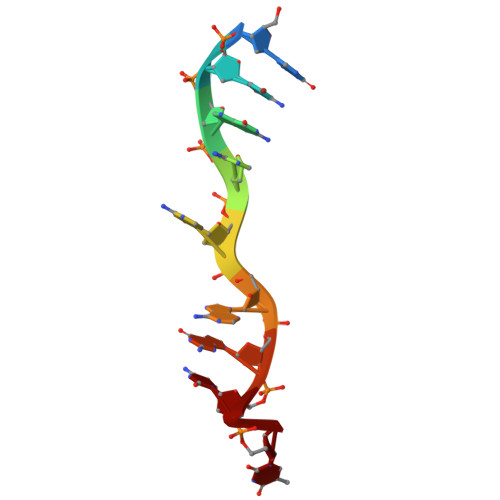A zipper-like duplex in DNA: the crystal structure of d(GCGAAAGCT) at 2.1 A resolution.
Shepard, W., Cruse, W.B., Fourme, R., de la Fortelle, E., Prange, T.(1998) Structure 6: 849-861
- PubMed: 9687367
- DOI: https://doi.org/10.1016/s0969-2126(98)00087-2
- Primary Citation of Related Structures:
376D - PubMed Abstract:
The replication origin of the single-stranded (ss)DNA bacteriophage G4 has been proposed to fold into a hairpin loop containing the sequence GCGAAAGC. This sequence comprises a purine-rich motif (GAAA), which also occurs in conserved repetitive sequences of centromeric DNA. ssDNA analogues of these sequences often show exceptional stability which is associated with hairpin loops or unusual duplexes, and may be important in DNA replication and centromere function. Nuclear magnetic resonance (NMR) studies indicate that the GCGAAAGC sequence forms a hairpin loop in solution, while centromere-like repeats dimerise into unusual duplexes. The factors stabilising these unusual secondary structure elements in ssDNA, however, are poorly understood. The nonamer d(GCGAAAGCT) was crystallised as a bromocytosine derivative in the presence of cobalt hexammine. The crystal structure, solved by the multiple wavelength anomalous dispersion (MAD) method at the bromine K-edge, reveals an unexpected zipper-like motif in the middle of a standard B-DNA duplex. Four central adenines, flanked by two sheared G.A mismatches, are intercalated and stacked on top of each other without any interstrand Watson-Crick base pairing. The cobalt hexammine cation appears to participate only in crystal cohesion. The GAAA consensus sequence can dimerise into a stable zipper-like duplex as well as forming a hairpin loop. The arrangement closes the minor groove and exposes the intercalated, unpaired, adenines to the solvent and DNA-binding proteins. Such a motif, which can transform into a hairpin, should be considered as a structural option in modelling DNA and as a potential binding site, where it could have a role in DNA replication, nuclease resistance, ssDNA genome packaging and centromere function.
- LURE, Université Paris-Sud, Orsay, France. shepard@lure.u-psud.fr
Organizational Affiliation:

















